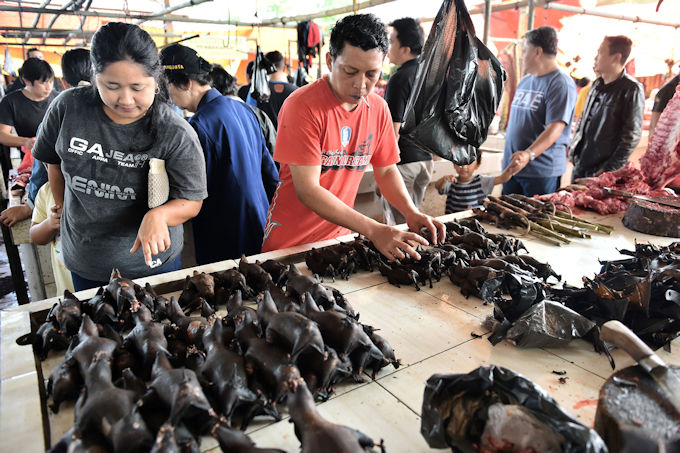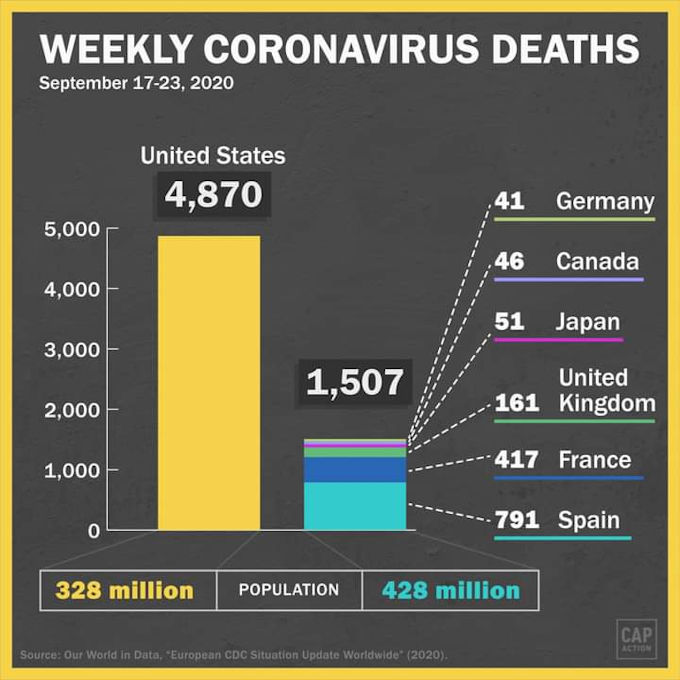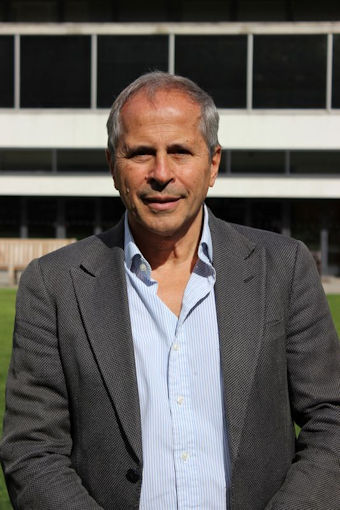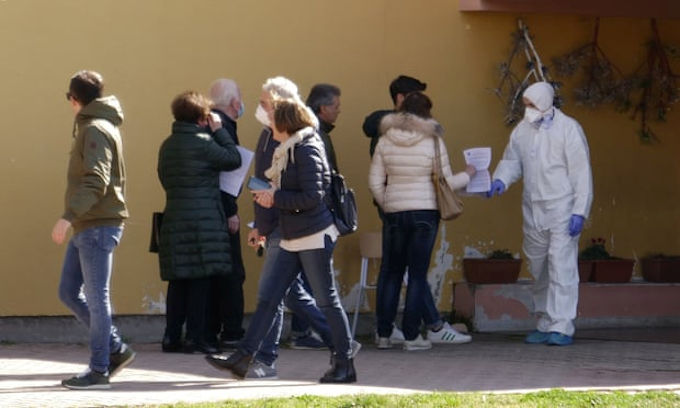
Lack of Public Health preparation made societies vulnerable.
The Next Pandemic
The point of writing this is to inform ourselves about the next pandemic. We have seen that the medical response to an epidemic, and the public health response are very different things. We have seen that good leadership and public trust in the leadership, can make all the difference to the number of people who become infected, and to the number of severe cases in any community. Italy had excellent medical facilities, but the public health response was weak. Taiwan on the other hand had an excellent public health response, and their medical facilities were hardly extended.
The Wild Animal Connection

A wet market in vietnam
Bat meat on sale.
The Transport Connection
Just over 120 years ago, people began to move more quickly and easily around the world. What began in a village was unlikely to stay in the village. After WWI, ships with returning troops from the war, carried the 1918 Spanish Flu home. Across the world, about 30% of the population became infected. In some places that killed 20% of the population. In India, the long distance railways that were a triumph of British occupation, were also the vehicle that enabled the spread of disease. Today with Covid-19 public transport is an easily identified danger spot, where a group of strangers are crowded together for period of time in a poorly ventilated space.
Of course cruise ships became iconic cases of a large number of strangers captured in a relatively small space, for several days. If infection hit the ship, that created a situation were nobody could leave the ship. This lasted for many weeks in some cases. ![]() The Diamond Princess was the most notable case, but many ships became traveling sources of infection. That includes at least one ship of the US Navy.
The Diamond Princess was the most notable case, but many ships became traveling sources of infection. That includes at least one ship of the US Navy.
Finally, air travel. Quick and efficient it may be, but it also transmits a new disease around the world in less than 24 hours.
The Governance Connection
With Covid-19 governance decisions were being made in a context where the best evidence was weak. There were existing protocols for dealing with pandemic's, which included not locking down and not wearing masks. There was also the hope that the vulnerable population would be small, and the infection rate low.
The difference between those places with good governance and those with poor governance, is like the difference between night and day. Most countries failed badly. In the absence of information what does a decision maker do? Ask for more information. (See ![]() Deaths by Selected Countries.)
Deaths by Selected Countries.)
So almost everywhere, lacking any real knowledge, governments delayed taking action. That seems to be a "safe" decision but it's also a failure strategy. Any new information they got within say 10 days, was at best provisional and most likely wrong. By then it's too late to easily capture the original disease cluster.

One of many bad weeks, USA
In this context Sweden comes up. Sweden has a tradition of following the advice of expert panels. Political interference with the advice of those experts would be frowned upon. They kept the economy open, hoping that herd immunity would quite soon begin to protect the community. That advice was in line with the WHO advice in the beginning. But later the WHO was very strong about the need for lockdowns, mask wearing, testing and contact tracing. Sweden was late in adopting those policies.
Chinese Health Officials: Imagine you are the doctor in a Wuhan hospital. You get one case, then 3 more, eventually 7, all connected, and with a strange disease. One of your patients dies on 9th January, 2020. Hospital managers probably discussed this situation. We don't know what happened in detail, but on the basis of what you know, what do you do? Seek more information! By the 20th January, Dr. Zong Nanshan, says; "It is most likely that the virus came from animals. It appears that human to human transmission is occurring."

Chinese New Year in Hong Kong - 2021
Note that they are wearing masks.
The context is critical. The Chinese New Year begins on 25th of January, and lasts for 15 days. Traditionally all those who can, go back to the village of their parents. There is huge movement of people across the country. Travel arrangements and plans are made long in advance. Now Chinese officials are involved, but they are trapped between the virus and the Chinese New Year. Of course they ask for more information. There are more cases in Wuhan, On 23rd January, a hard lockdown was ordered in Wuhan. But the news of that was delayed, on the 25th January people were advised that it was safe to travel for the Chinese New Year. We now know that, this was a mistake. This was the first of MANY super-spreader events. By the end of January, Covid-19 is already in 25 countries. (Air travel made this possible, in just over 10 days the virus was spread across the globe.) However, note in the photograph that at least in Hong Kong people were wearing masks.
Chinese Politicians: You can see the problem for regional Chinese politicians. The Chinese New Year, is the major event of the year. Are you going to cancel that, because a few people who seem to be confined to one city, are sick? What happened in detail we don't know, but what would you do? Ask for more information, and allow the Chinese New Year to proceed. Apparently that's what happened. Donald Trump's criticism of the Chinese authorities seems particularly unfair, given his own inability to act, much later, with much better information about the virus.
The World Health Organisation
The WHO is one of many UN organisations which is under funded and understaffed. With Covid-19, they struggled to understand the virus in the beginning. They were a little slow in declaring a pandemic, their original advice about mask wearing was on reflection wrong. But given the failures everywhere else, in my view they seem to have done well. In March 2020 Mark Ryan of the WHO advised countries to lock down fast and to have no regrets about doing it. "The virus will get you if you don't act quickly."
President Donald Trump, would have none of that. Trump decided that the WHO and China were lying. The WHO was never strong, and Trump tried to further reduce the influence of the WHO by threatening to defund it in April, 2020. Trump said that China had not properly reported information it had about the coronavirus to the World Health Organization and said China had pressured the WHO to "mislead the world."
From the Guardian; 19 September, 2020:
Dr Mike Ryan of the World Health Organization, warned the coronavirus is 'not going away,' as the current global weekly death toll temporarily plateaued at around 50,000.
Asymptomatic Transfer of the Virus

Prof. Andrea Crisanti
In Italy, the first case died on 23rd of February, but already many people were sick. This person lived in a small Italian town of just over 3000 people. ![]() Prof. Andrea Crisanti tried to imagine how the Virus spread so quickly. His theory was that people who were asymptomatic must be spreading the virus.
Prof. Andrea Crisanti tried to imagine how the Virus spread so quickly. His theory was that people who were asymptomatic must be spreading the virus.

Street Testing for Covid-19
Town of Vo in Italy.
With the agreement of the town, there was an immediate 14 day lockdown. Intensive PCR testing, was immediately begun, made possible by the technology and training at Padua University. So in a short time they began to give PCR tests to everyone, and discovered significant infection rates among people who had no symptoms. 86% of the population was tested for Covid-19 within a few days. Seventy-three people (2.6%) tested positive, many showing no symptoms. At the end of the 14 days, 72% of the population was retested. Only 29 people tested positive 1.2%). This study demonstrated that in two or three weeks a lockdown could stop the spread of the virus. The silent transmission of the disease could be controlled.
There were two other important findings. First, that no child under 10 years of age caught the disease even thought they lived in a home where adults were infected. Second, if any adult in a house was infected, other adults in the same home seldom escaped being cross infected. ![]() Here is a link to the Guardian Newspaper.
Here is a link to the Guardian Newspaper.
This was reported informally in March, 2020, with not much interest shown. ![]() A formal paper was published in "Nature" on 30th of June, 2020. Prof. Crisanti's team had proven that quarantine works, that everyone was a potential carrier of the virus, and that identifying cases, contact tracing, and community wide testing could stop the virus in two or three weeks. He concluded that there was significant asymptomatic transfer of the virus before people develop symptoms, in about 40% of those tested.
A formal paper was published in "Nature" on 30th of June, 2020. Prof. Crisanti's team had proven that quarantine works, that everyone was a potential carrier of the virus, and that identifying cases, contact tracing, and community wide testing could stop the virus in two or three weeks. He concluded that there was significant asymptomatic transfer of the virus before people develop symptoms, in about 40% of those tested.
However, Very few people seem to have understood that message even after the publication of these findings in "Nature". I'm reminded of the public health work Dr John Snow did in London, to stop the cholera epidemic. He had to find the source, in this case a rat infected public water pump. To stop the epidemic the most effective action was to remove the handle. Prof. Crisanti would say the source is the asymptomatic transfer of the virus. Lock-down is and effective way to stop that.